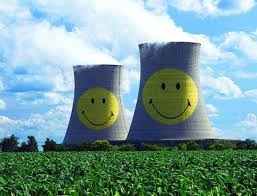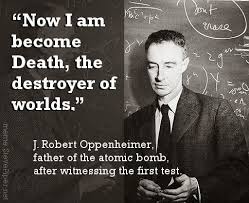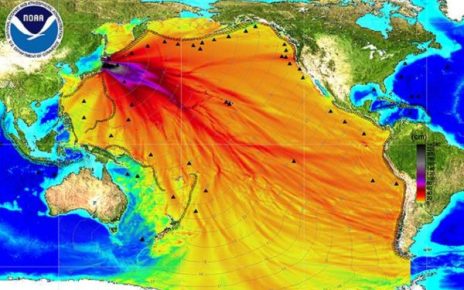Regarding the future, it can be measured and statistically quantified (although certainly never precisely) in a number of ways, some of which certain people might argue are nonexistent, and others being more tangible, irrefutable concepts. For instance: global population as a trajectory of future standpoint, or current geopolitical structures, the scope of global agriculture, or the current state of energy production and consumption; case in point, nuclear energy. The ability to manipulate interatomic energies is something humans have only had for about six decades now, which is poetically subatomic on the grand scales of Time, and global inconclusiveness, indecision, and naivety regarding nuclear energies have been duly noted to help push us all onto a precarious and teetering tightrope of worldly energy affairs. Says physicist Kirk Sorensen, in terms of the bioavailability of Uranium-235 (which is derived from naturally occurring, unaltered uranium at a very small rate and is our current technological source of nuclear energy): using it as an energy source is statistically very close to burning through platinum as an energy source. Today, the United States accounts for 33% of the Earth’s nuclear energy, with nearly 20% of the country’s sum total of energy being nuclear. To some this may not seem like an overwhelming statistic, but with 100 commercial reactors and 65 full nuclear power plants in this country alone, it most assuredly is a  problem. However, let it be known (but set aside for a moment) that this article is not about the condemnation of nuclear energy as an entire spectrum nor any specific advocating of an alternative, but rather that modern nuclear energy protocol is in disrepair and it is imperative that humans abandon it as a species and search for a variant development or an entirely new process for energy production.
problem. However, let it be known (but set aside for a moment) that this article is not about the condemnation of nuclear energy as an entire spectrum nor any specific advocating of an alternative, but rather that modern nuclear energy protocol is in disrepair and it is imperative that humans abandon it as a species and search for a variant development or an entirely new process for energy production.
A clear concern with any nuclear reactor is the release of radioactive, exponentially cancerous chemicals from its facility. So naturally, the first step to understanding nuclear power from the standpoint of an energy consumer would be, “What is radioactivity?” Taken from the internet, from Georgia State University’s HyperPhysics page:
‘Radioactivity refers to the particles which are emitted from nuclei as a result of nuclear instability. Because the nucleus experiences the intense conflict between the two strongest forces in nature, it should not be surprising that there are many nuclear isotopes which are unstable and emit some kind of radiation. The most common types of radiation are called alpha, beta, and gamma radiation, but there are several other varieties of radioactive decay. Radioactive decay rates are normally stated in terms of their half-lives, and the half-life of a given nuclear species is related to its radiation risk. The different types of radioactivity lead to different decay paths which transmute the nuclei into other chemical elements. Examining the amounts of the decay products makes possible radioactive dating. Radiation from nuclear sources is distributed equally in all directions, obeying the inverse square law.’
In a more traditional and less scholarly worded way, each and every thing in existence is created due to a vibrational frequency; i.e. as far as modern Quantum Physics is concerned, everything is Sound. And so, in a very real and quantifiable, scientific sense, a “thing” in existence can be seen abstractly as a radio transmitter receiver—the human brain being a less abstract and actually quite accurate analogy. So if each and every thing—each and every human, let’s say—has its own fundamental frequency of self that is constantly being transmitted and broadcast, physics shows that when other chemicals that are transmitting signals—are acting as a radio—in a specific, biologically counterproductive context, they then begin to act as a signal transmission jammer. To speak descriptively and without official scientific terminology: when a human acquires too much of what one could call “ethno-radiation” as opposed to a person’s natural biological state of “endo-radiation”, their signal begins to fade, their cells start to lose focus, and cancer begins to spread, further “jamming” the “signal” to the cells. The Ancient Egyptians understood these concepts at least fundamentally without question, worshipping one of human history’s first and most notable monotheistic gods: Atum. Egyptians regarded Atum as omnipresent, the unmanifest of the manifested, the divine within all man—the very shape of us and the rest of the universe being in Atum’s eternal image. Indeed this is not even the only mention of ancient accounts of nuclear awareness, even J. Robert Oppenheimer quite ambiguously said of the Manhattan Project’s official trial success, “I remembered the line from the Hindu scripture, the Bhagavad Gita, ‘Now I am become death, the destroyer of worlds,’”, even going so far as to reply (again quite ambiguously) when asked in interview if this was the first nuclear explosion, “Yes, in modern times.” While this article is not exactly trying to claim that ancient civilizations had nuclear technology, it should be noted that the concepts of the atom, radioactivity, and other scientific concepts intrinsic to human life were clearly known in one form or another to our ancestors. To say that our forefathers throughout history were blind to the basic fundamental aspects of human biological function and survival is unquestionably arrogant, especially when we are in part talking about the men who built the pyramids. This is a well-documented and largely undiscussed thread of human thought that has followed us for a long time, and the fact that we are now using the power of the Egyptian All-Father to power 20% of the US shows us that it is imperative that the collective human species begin to not only hop on the same page regarding atomic energy, but that it should probably start writing something on that page as well.
of worlds,’”, even going so far as to reply (again quite ambiguously) when asked in interview if this was the first nuclear explosion, “Yes, in modern times.” While this article is not exactly trying to claim that ancient civilizations had nuclear technology, it should be noted that the concepts of the atom, radioactivity, and other scientific concepts intrinsic to human life were clearly known in one form or another to our ancestors. To say that our forefathers throughout history were blind to the basic fundamental aspects of human biological function and survival is unquestionably arrogant, especially when we are in part talking about the men who built the pyramids. This is a well-documented and largely undiscussed thread of human thought that has followed us for a long time, and the fact that we are now using the power of the Egyptian All-Father to power 20% of the US shows us that it is imperative that the collective human species begin to not only hop on the same page regarding atomic energy, but that it should probably start writing something on that page as well.
This is a noteworthy historical apex that has yet to be concluded. However, the saga has certainly raged and continues to do so with catastrophes such as Pennsylvania’s Three Mile Island Reactor crisis in 1979, the nuclear meltdown of Chernobyl Ukraine in 1986, Japan’s Fukushima Daiichi disaster of 2011, as well as Long Island’s Indian Point nuclear reactor that remains active despite the local community’s continuous uproar about proven reactor leakage and local deaths to cancer. Here in Alaska, Fukushima has become the hush-hush low murmur that locals have become too afraid to talk about. The old-timers ignore it, the adults immediately set it aside because, well, this is where their life is and they can’t just up-and-leave on the account of speculation. And of course, the young people who have not been blinded by western culture or by drugs or both (people who are sometimes few and far in between around here) are outraged and concerned for their personal futures and the state’s future as well. When “Fukushima” is typed into the Google search bar, one of the first suggestions becomes “Fukushima radiation Alaska”, and this author has personally talked to fishermen and local seafood chefs who have talked about radioactive contamination in the Alaskan environment, most notably the salmon, halibut, crab and the rest of Alaskan seafood, as well the organisms that consume them. However it should be heavily noted that in no way were any of these local comments results from scientific methodology, but word-of-mouth through the frontier, and should be taken with a grain of salt. Australian physician and anti-nuclear activist Helen Caldicott has been traveling the globe since the Cold War, trying to alert people of the severe and inherent dangers of our current nuclear energies and has gone on record speaking of the repercussions of the aforementioned nuclear events, claiming that products like Hershey’s chocolate should be now noted to have trace radioactive risk, being located just miles away from the Three Mile Island plant during the crisis, where it continues to reside today. However in regards to the full spectrum of TMI fallout there seems to remain great debate—official public record claiming that the long-term ramifications have already been proven to be “low-level”, but with the government’s massive media dodging during the TMI crisis and seemingly throughout all nuclear crises to date, one can’t help but feel wary, and any lack of long-term effect does not atone for the lives lost during the original leakage. But of course, none of these effects compare to the severe and monstrous bombardment that Japan has received from one of the only two Level 7 nuclear events in recorded history (Chernobyl being the other) and history’s first two atomic bombs used in warfare; and lastly, but not least on the list: the radioactive land surrounding the Chernobyl plant that is the size of Great Britain and the most radioactive piece of land on the planet.
But fret not, for in regards to radioactive chemicals, their radioactive “potency” varies quite vastly, and this “potency” is generally measured in years, through the concept of half-life. Wikipedia explains it as such: “A half-life usually describes the decay of discrete entities, such as radioactive atoms. In that case, it does not work to use the definition ‘half-life is the time required for exactly half of the entities to decay’”. In other words, no science is exact, but this is the decay rate of the radioactive chemicals measured in halves, and these are the proportions at which those halves decay. However, there’s more to it. If one radioactive isotope has a half-life of a day, and another for five billion years, then I’m sure many readers would be inclined to believe that the isotope that is active for two days is far less dangerous than something that is going to be radioactive for ten billion years, but it turns out that the truth of the matter couldn’t be more opposite. Radioactivity works in condensed quantities of emission that seem to be predetermined by nature and time-released through natural decay, which is what a half-life is. So in short, if someone is theoretically radioactive for two, and the other for ten billion years, the man of two days has such an astronomical release rate of the contained energy that he is deathly radioactive, while the man who is theoretically radioactive for ten billion years will be statistically completely unaffected by the isotope because of the gargantuan cushion of decay rate. This point is important, because although nuclear energy seems to be a general hazard, there are such things as Fear-Mongers within every school of thought, and when people speak of radioactive hazards, often they have never even thought about the science behind half-life decay, nor the other forms of radioactive measurement, such as becquerels (Bq) which is a unit of measurement for a radioactive nucleus’ decay rate per second.
So when things begin to be broken down in this light, the results on the environment (and humans within it) become a bit more sporadic and tedious to trace and document, especially when governments across the board are historically incredibly sneaky when it comes to adverse nuclear affects large or small, and we are seeing nothing different with Fukushima and its affects—and with Alaska being just about the closest frontier that the West has to Japan, it has become one of the main stages in the measurement of Fukushima’s affects. Well, in 2014 the FDA came out with an environmental study of the state of Alaska, claiming that it was safe of the three radioactive isotopes that any human need worry about in regards to Fukushima contamination. Quoting the Anchorage Daily News:
“The testing found no detection of the Fukushima-related radioisotopes Iodine-131, Cesium-134, or Cesium-137,” the statement said. “There was some detection of background or naturally occurring radiation. The results indicate no appreciable risk from any tested radionuclides in these fish.”
It’s not this article’s place to question the Food and Drug Administration, but with questionable calls such as the legalization of genetic laser modifications of foods with Round-Up pesticides, hormones and antibiotics in the dairy, fluoride in the water, and the flux of pharmaceutical medications, does anyone feel very comforted by anything the FDA says these days?
The point is this: because the concept of nuclear energy was never fleshed out to begin with, global geopolitical structures continue to be reassuring the public of something that remains inconclusive and largely unverified. And a sad fact of the matter is that this has happened because of governments’ willingness to fund uranium energy due to its byproducts’ usefulness in nuclear weapons. With the US government’s current concern about programs like the Iranian nuclear program, weapons could not be more on people’s minds. It seems that Americans in fact do not like the taste of their own medicine, because in the long run this is how the entire planet feels about the US and has felt for quite some time now, and the real problem with worrying about what other governments are doing is the “Us Versus Them” mentality that this facilitates, and when this is facilitated, it’s quite easy to insert concepts of “good” and “evil” behind the opposing entities as well, when in reality the “Us” could be equal to the “Them”. Instead of condemning other countries for doing what the US itself does (when the US should be leading by example), it is perhaps a more accurate assessment to measure the pros and cons of Nuclear Energy itself, the cons of traditional nuclear energy seeming to blatantly outweigh the pros.
To quote the great Albert Einstein, “You cannot solve a problem from the same consciousness that created it. You must learn to see the world anew,” and energy consumption is certainly not exempt from this common sense rationale, is it? Alternatives such as harnessing the elements of the wind and the sun can be viable options (with dam and battery power becoming largely un-viable options) but unfortunately due to funds in nuclear efforts, these alternative energies are largely undeveloped and thus oftentimes very underwhelming in their energy production statistics and their environmental invasiveness. But this is not because of these sources’ ineffectiveness, but more pointedly because of, again, the fact that no one is on the same page with energy consumption, and if half of the government’s nuclear budget was put towards wind or solar, it’s a statistical certainty that we would all start to see results. But Einstein’s quote does not have to be taken in this context as the abolishment of all nuclear energy, for there seems to be a promising new, untapped and non-radioactive nuclear energy source so abundant in nature that humans would never run out—and it is called, after the Nordic god, Thorium. This chemical is one of the only three primordial elements found in nature, along with bismuth and uranium, and although technically radioactive, Thorium has a half-life of 14 Billion Years, which is statistically equivalent to “jack shit”, and is the longest lived of all discovered isotopes. And as if this already didn’t sound appealing enough, Thorium cannot be used to make nuclear weapons—because, again, this is what it all boils down to: the military and their weapons.
The Manhattan Project was not a calculated, thorough investigation of nuclear energy: it was the maddest of mad dashes to create something that could be used to create an atomic bomb as quickly as possible, and when the war ended, the shift of nuclear in the economy went from “bombs” to “energy”. Energy had scientists looking at two specifics avenues: Thorium and Uranium, and since they had all been working with uranium during the war and were familiar with it, it was decided that uranium was the wisest and most economic decision. And again, just to clarify: it was the most economic decision because it had been the fruits of a mad dash to create a weapon that killed millions and millions of people. The nuclear reactors that are all over the country and the world are creating raw materials for these weapons actively, and they are going straight to the given reactor’s government. But allow this article to digress to the point of this paragraph: that Thorium has been around just as long as any other nuclear energy and that it was overlooked merely for superficial and detrimental reasons. Even China has no gone on public record funding billions of dollars into the energy production of Thorium, through what are called Liquid Fluoride Thorium Reactors or LFTRs. (It also seems a bit ironic that fluoride, which is a neurotoxic byproduct of the pharmaceutical industry, can be actually beneficially used in a form of safe energy production—and yet it is still being added to the national public waters instead.) For more information on Thorium and its potential, visit EnergyFromThorium.com or find any of the many informative youtube.com videos.
In his book Twilight of the Idols, Friedrich Nietzsche reminds all of the important notion of “egyptism”, the name he coined for what happens when cultures and individuals alike clasp onto schools of thought for so very long that they become mummified, lifeless, and useless. In order to avoid this, there is the need to spread the information that one believes in. “We the People” are the ones who have the ultimate say, for it is the majority. All great minds alike seem to agree that, one way or another, our current global energy situation is dangerous and impractical, and so if it continues to remain like this then the fault lays solely on the shoulders of the people—the majority. Nuclear energy in a world that has not matured enough to handle nuclear energy is obviously not the healthiest rationale, and whether we find our energy in alternative sources such as wind or solar, or a totally variant form of technology such as Liquid Fluoride Thorium Reactors, humans must cast aside their mummified concepts in order to make way for the flesh and blood of generations to come. It seems that neither Three Mile Island, nor Chernobyl or Fukushima have been yet enough of a rousing, and the fault of any future catastrophes in the Age of Information will lay only in the lack thereof. But just because mistakes have been made does not mean that mistakes need to be continued—because in the end, there is always a choice, and making a choice to begin with is perhaps the most important step.





